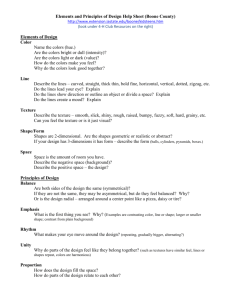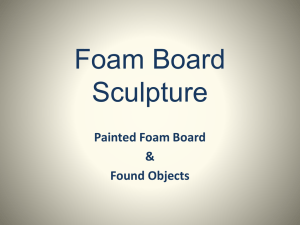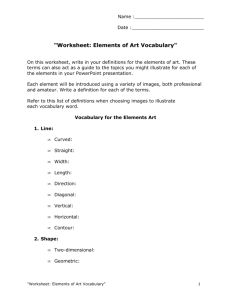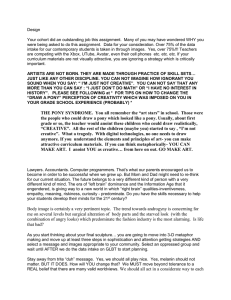Introduction to Art: Semester 1/Final Review
advertisement
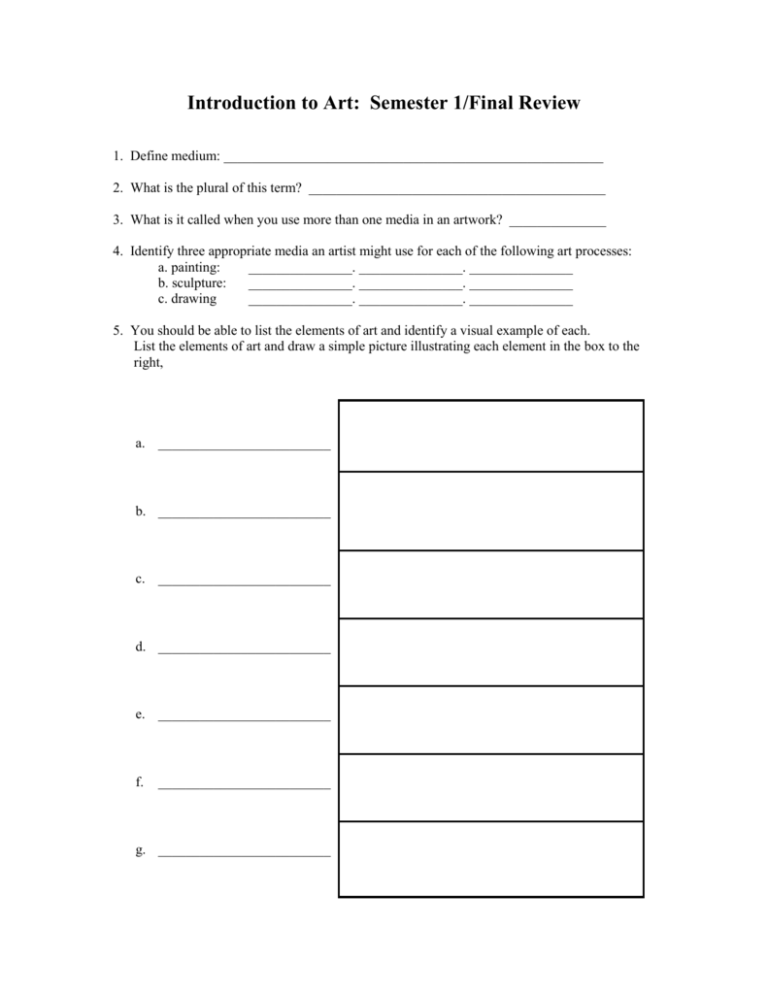
Introduction to Art: Semester 1/Final Review 1. Define medium: _______________________________________________________ 2. What is the plural of this term? ___________________________________________ 3. What is it called when you use more than one media in an artwork? ______________ 4. Identify three appropriate media an artist might use for each of the following art processes: a. painting: _______________. _______________. _______________ b. sculpture: _______________. _______________. _______________ c. drawing _______________. _______________. _______________ 5. You should be able to list the elements of art and identify a visual example of each. List the elements of art and draw a simple picture illustrating each element in the box to the right, a. _________________________ b. _________________________ c. _________________________ d. _________________________ e. _________________________ f. _________________________ g. _________________________ 6. What is the difference between a fine and a functional art? ____________________________ ______________________________________________________________________________ ______________________________________________________________________________ 7. Give an example of functional art: _______________________________________________ 8. Give an example of a fine art: ___________________________________________________ 9. What is an implied line? ______________________________________________________ ______________________________________________________________________________ ______________________________________________________________________________ 10. What is the difference between calligraphy and a calligraphic line? ____________________ ______________________________________________________________________________ ______________________________________________________________________________ 11. What is the difference between an outline and a contour line? ________________________ ______________________________________________________________________________ ______________________________________________________________________________ Define the following terms and explain how they relate to value. Give examples 12. Light source: _______________________________________________________________ ______________________________________________________________________________ Example: 13. Highlights: _________________________________________________________________ ______________________________________________________________________________ Example: 14. Transform the circles below into spheres by adding changes in value. Use the four different shading techniques and label each one. What should you consider before you begin shading? ____________________________ ______________________________ ______________________________ ______________________________ _____________________________ 15. What is the difference between shapes and forms? _________________________________ ______________________________________________________________________________ ______________________________________________________________________________ 16. What are the two kinds of shapes? Draw an example of each: a. _____________________ b. _____________________ 17. What are the different types of forms? Draw an example of each: a. ______________________ b. _______________________ 18. What is the difference between an organic and a geometric form? ____________________ ______________________________________________________________________________ ______________________________________________________________________________ Give an example of each: _________________________________________________________ ______________________________________________________________________________ 19. Which element of art do you use to make shapes look like forms by shading darker and lighter areas? ________________________________________________________________________ 20. Is sculpture a 2-dimensional or a 3-dimensionsal art form? ___________________________ 21. a. Freestanding sculpture: __________________________________________________ ________________________________________________________________________ b. Relief Sculpture: _______________________________________________________ ________________________________________________________________________ Perspective is a graphic system that creates the illusion of depth and volume on a twodimensional surface. There are 6 techniques or devices that artists use to give their work perspective. 22. Fill in the blanks below that describe the different techniques and then illustrate how each of these techniques is used in a small sketch or drawing. a. __________________________: when one object covers part of a second object, the first object appears to be closer. Illustrate: b.__________________________: large objects appear to be closer than small objects. Illustrate: c. __________________________: objects placed low on the picture plane appear closer to the viewer when placed at eye level. Illustrate: d. __________________________: objects with clear sharp edges and visible details seem to be close to you while objects with hazy outlines appear farther away. Illustrate: e. __________________________: where converging lines meet a vanishing point or points on the horizon to give the illusion of going off into space. __________-point perspective is when receding lines meet at a single vanishing point. Illustrate: 23. The surface of a painting or drawing is called the ___________________ _______________. 24. forground:__________________________________________________________________ ______________________________________________________________________________ 25. middle ground: ______________________________________________________________ ______________________________________________________________________________ 26. background: ________________________________________________________________ ______________________________________________________________________________ 27. Positive space. ______________________________________________________________ ______________________________________________________________________________ 28. Negative space. _____________________________________________________________ ______________________________________________________________________________ 29. If you were shown a picture of two children playing, what would the positive space be? ______________________________________________________________________________ 30. If you were shown a freestanding sculpture of a gigantic clothespin, what would the negative space be? _____________________________________________________________________ 31. A tool that artists use to organize colors by bending the color spectrum into a circular formation is called: ______________________________________________________________ 32. What is a hue: _______________________________________________________________ 33. How can you change the value of a hue? _________________________________________ 34. What do you call a hue in which you added black to make it darker? ___________________ 35. What do you call a hue in which you have added white to make it lighter? _______________ 36. What is a tone and how do you make one? ________________________________________ 37. Colors that are opposite each other on the color wheel are called: _____________________ 38. What does the intensity of a hue refer to? _________________________________________ ______________________________________________________________________________ 39. How do you change the intensity of a color? ______________________________________ ______________________________________________________________________________ 40. When two hues that are opposite from each other on the color wheel are mixed together they start to become a neutral gray color. The colors are sometimes called __________________. 41. Color schemes are plans for organizing colors. Define the following color schemes and give an example of each. a. Monochromatic: _______________________________________________________ Example:_________________________________________________________ b. Analogous: ___________________________________________________________ Example:_________________________________________________________ c. Complementary: _______________________________________________________ Example:_________________________________________________________ d. Color Triad: __________________________________________________________ Example: _________________________________________________________ e. Split complement: ______________________________________________________ Example: _________________________________________________________ f. Warm colors: _________________________________________________________ Example: _________________________________________________________ g. Cool colors: ___________________________________________________________ Example: ________________________________________________________ 42. Write in the hues in their correct order on the color wheel below: Yellow Yellowgreen 43. What is the difference between Real and Visual texture? ____________________________ ______________________________________________________________________________ ______________________________________________________________________________ 44. What is the difference between Simulated and Invented texture? _____________________ ______________________________________________________________________________ ______________________________________________________________________________ 45. Draw and example of each in the boxes below: Simulated texture Invented texture 46. Through which two senses do we perceive texture? ______________________________________________________________________________ ______________________________________________________________________________ ______________________________________________________________________________ Almost done, just a few more on next pages. Which of the images below is a/an: 47. Sculpture 48. Still life 49. non objective 50. abstract 51. portrait A. C. E. B. D. Use the information on the credit line of the image below to answer questions 52-56 Manet, Edouard, A Bar at the Folies-Bergere, 1881, Oil on canvas, 37.8” in × 51.2 “, Courtland Institute Galleries, London. 52. What medium did the artist use? ________________________________________________ 53. Who was the artist of this work? ________________________________________________ 54. What is the size of this work? __________________________________________________ 55. What is the title of this work? __________________________________________________ 56. Where is this work now? ______________________________________________________

